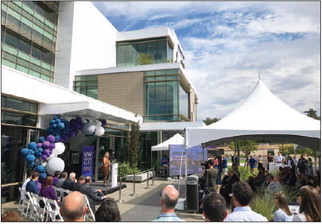Next Generation of Health Professionals
Thursday, September 8, 2022

(as reported in The Spokesman-Review by Colin Tiernan; also see this Gonzaga News article)
$60 million, 90,000-square-foot joint GU-UW medical school building in Spokane opens following ceremony
With the ceremonial snip of surgical scissors through medical gauze, students, professors and politicians on Wednesday christened a $60 million health sciences building in Spokane.
Gonzaga University and the University of Washington School of Medicine are sharing a 90,000-square-foot facility along the Spokane River, near the Hamilton Street exit off Interstate 90.
The building has classroom space for UW graduate students and Gonzaga undergraduates studying human physiology, nursing and health sciences.
The gauze-cutting ceremony doesn’t mark the actual opening of the building – UW started classes there in July. But it’s still a major milestone in the Gonzaga-UW medical school partnership that began in 2016.
“Today, we open the door to the next generation of health professionals,” UW President Ana Mari Cauce told the crowd. “This building is an amazing
accomplishment.”
Until recently, Spokane had one medical school that UW and Washington State University had run jointly for 40 years.
In 2015, WSU decided it wanted a school of its own. The state’s foremost public universities split, and Spokane ended up with two medical schools. UW students can complete the first 18 months of their degree in Spokane while WSU medical students stay in the city for all four years.
Gonzaga President Thayne McCulloh said the partnership with UW has gone well.
“We expanded the family of Bulldogs to include Huskies,” he said, “and we found that both breeds are quite compatible.”
Neither Gonzaga nor UW will own the $60 million building. Instead, they’re leasing it from the Emerald Initiative, an affiliate of the Seattle- based real estate developer McKinstry.
Besides classrooms, the facility has a handful of features that cater specifically to the health sciences.
A cadaver room, full of 20 stainless steel dissection tables, is the crown jewel of the first floor.
The second floor has an environmental chamber that students can use to run experiments at different temperatures, humidity levels and atmospheric pressures.
The fourth floor is empty. Patrick Farley, a principal with the Emerald Initiative, said his business plans to find a biotech company to lease that space.
Students, elected officials and university presidents alike said they hope the new building will help address the health care worker shortage in rural Washington.
That shortage can reduce access to health care for people who live in rural areas. No one should get worse health care just because they live in the wrong zip code, said Rep. Marcus Riccelli, D-Spokane.
“This is America,” Riccelli said, “we’re better than that.”
Colin Tiernan can be reached at (509) 4595039 or at colint@ spokesman. com.